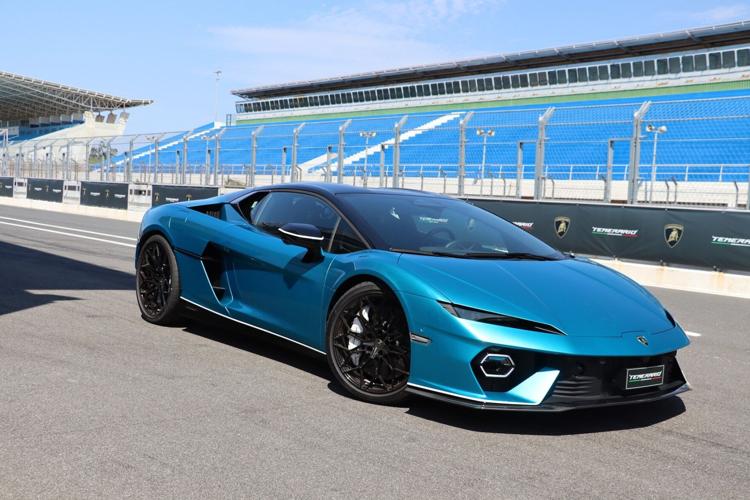ESTORIL, PORTUGALŌĆöŌĆ£We give adrenalin a shape.ŌĆØ With that quick quip, Mitja Borkert, head of design at Lamborghini, put those in attendance at the launch of the Temerario on notice. Prepare to see what form this excitement would take?
I’m in Estoril, a town just outside of the Portuguese capital of Lisbon, to see just what Lamborghini has up its sleeve when it comes to the latest version of the brandŌĆÖs ŌĆ£babyŌĆØ supercar. Like the Hurac├Īn before it and the Gallardo before that, the Temerario doesnŌĆÖt have the marqueŌĆÖs biggest engine ŌĆö its signature V12, reserved for the Revuelto ŌĆö but a twin-turbo hybrid V8. So, ŌĆ£baby.ŌĆØ
Sliding behind the flat-bottomed and partially carbon fibreŌĆÖd steering wheel, I have a hard time thinking thereŌĆÖs anything babyish going on at all. The wheel is loaded with everything from turn indicator controls to adjustment knobs for the hybrid system and chassis and even the three-level drift mode.
The Temerario has a longer wheelbase than the Hurac├Īn, is taller and has more room inside. It also gets two digital displays as standard (one for the gauges, another for infotainment, including wireless Apple CarPlay and Android Auto), plus an optional third item ahead of the front passenger. It can hit 340 km/h and sprint from stop to 97 km/h in a paltry 2.7 seconds with launch control activated. ThatŌĆÖs what 907 horsepower from a twin-turbo V8 with three EV motors and all-wheel-drive gets you and itŌĆÖs all done while revving ŌĆö hold onto your socks! ŌĆö to a stratospheric 10,000 RPM limit.
The Temerario keeps the classic low Lambo profile, but it adds more flare with a shark-nose front end, ultra-narrow headlights with octagon-shaped LED fog lights underneath and three distinct wheel styles. Those come wrapped in bespoke Bridgestone Potenza tires measuring 325 millimetres in back. In a nod to the classic Countach, Borkert and his team cut away the bodywork from around the rear wheels, revealing how wide the tires are. Add an aggressive underbody diffuser, octagon-shaped centre exit exhaust and gorgeous ŌĆ£Blu UranusŌĆØ paint and IŌĆÖm not sure I can keep myself from vibrating off the face of the planet into premium gas-fueled oblivion.
But, because IŌĆÖve come all the way to Portugal for this, IŌĆÖm going to try.
A press of a button hidden underneath a fighterjet-like flip-up door gets things started. A tug of the carbon fibre paddle shifter selects drive and then, the piece de r├®sistance: the press of a wheel-mounted button marked with a checkered flag to activate launch control. At which point, I hold my left foot on the brake, plant the throttle, release the brake and try my best to hold it together as all that sticky rubber grabs the tarmac and slings me forward like a boulder from a trebuchet. In less than a blink of an eye, 40 km/h┬Āand 50 km/h disappear, 60-80 km/h takes maybe a blink and a half, and, bam! 100 km/h and I are glued to the seat, the incurred Gs giving the sensation of the first drop on a roller coaster ŌĆ” times 10. Fair warning: I am on a controlled racetrack, which is the only place the launch control should be used.
Although the Temerario is powered by a hi-tech turbocharged hybrid motor, it feels more traditional. Any lag associated with the turbos is neutralized by the EV motors, so you get a nice, linear power band without the peaks and valleys of your typical turbo job. So I get all this massive acceleration, but a drive that feels nicely analogue.
The sensation of otherworldly performance doesnŌĆÖt stop once the straights do ŌĆö oh no. I have all that rubber (which can be upgraded to an even more race-ready spec, if the buyer so desires), adaptive dampers plus massive brake rotors and calipers. The EV motors can also be used to help slow the car and are engaged to pull out of corners more easily. Also, they help reduce understeer while cornering and permit for some very limited EV-only driving.
The result is a powerful, fat-tired supercar that changes directions like a go-kart. The Temerario rotates through tight left-right-left turns with an almost complete lack of inertia. Then, as the turns get faster, all the driver aids, EV motors and adaptive dampers come together to help stabilize things for faster cornering speeds.
As cool as the number sounds, that 10,000 RPM redline is something I never fully got used to. When you have that many revs to work with, the temptation to shift early is a hard one to shake. You end up robbing yourself of some power through short shifting because, typically, when you hear an engine wailing through 7,500 RPM, it is time to shift.
Talk about a minor gripe, though. The Temerario is an incredible machine, a wonderful look at how, when properly engineered, a hybrid system brings a dimension of performance that was unfathomable just a few short years ago. Giving adrenalin a shape? Yes, indeed. Perhaps it is the shape of things to come.

































To join the conversation set a first and last name in your user profile.
Sign in or register for free to join the Conversation